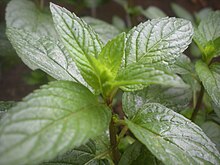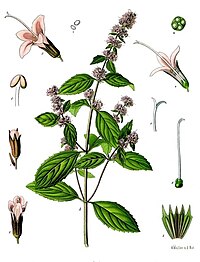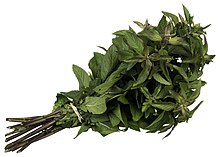Peppermint: Difference between revisions
Reinforced with 2011 Cochrane review (at that time said there's evidence for peppermint oil in IBS but newer review gave a stronger recommendation) |
|||
| Line 57: | Line 57: | ||
[[File:Pfefferminze ies.jpg|left|thumb|200px|Freeze-dried leaves.]] |
[[File:Pfefferminze ies.jpg|left|thumb|200px|Freeze-dried leaves.]] |
||
[[Peppermint oil]] has also been shown to be a safe and effective short-term treatment for [[irritable bowel syndrome]].<ref name=>{{cite journal|author=Khanna R, MacDonald JK, Levesque BG|title=Peppermint oil for the treatment of irritable bowel syndrome: a systematic review and meta-analysis|journal=Journal of clinical gastroenterology|volume=48|issue=6|pages=505-12|date=July 2014|pmid=24100754 |
[[Peppermint oil]] has also been shown to be a safe and effective short-term treatment for [[irritable bowel syndrome]].<ref name=Khanna2014>{{cite journal|author=Khanna R, MacDonald JK, Levesque BG|title=Peppermint oil for the treatment of irritable bowel syndrome: a systematic review and meta-analysis|journal=Journal of clinical gastroenterology|volume=48|issue=6|pages=505-12|date=July 2014|pmid=24100754|doi=10.1097/MCG.0b013e3182a88357}}</ref><ref name=>{{cite journal|author=Ruepert L, Quartero AO, de Wit NJ, van der Heijden GJ, Rubin G, Muris JW|title=Bulking agents, antispasmodics and antidepressants for the treatment of irritable bowel syndrome|journal=Cochrane database of systematic reviews|volume=8|issue=|pages=CD003460|date=August 2011|pmid=21833945|doi= 10.1002/14651858.CD003460.pub3}}</ref> According to the German [[Commission E]] monographs, peppermint oil (as well as peppermint leaf) has been used internally as an antispasmodic (upper gastrointestinal tract and bile ducts) and to treat irritable bowel syndrome, [[catarrh]] of the respiratory tract, and inflammation of the oral mucosa. Externally, peppermint oil has been used for [[myalgia|muscle pain]] and [[neuralgia|nerve pain]]. According to Commission E, peppermint oil may also act as a [[carminative]], [[cholagogue]], antibacterial, and secretolytic, and it has a cooling action.<ref>{{cite journal | last1 = Keifer | first1 = D. | last2 = Ulbricht | first2 = C. | last3 = Abrams | first3 = T. | last4 = Basch | first4 = E. | last5 = Giese | first5 = N. | last6 = Giles | first6 = M. | last7 = DeFranco Kirkwood | first7 = C. | last8 = Miranda | first8 = M. | last9 = Woods | first9 = J. | year = 2007 | title = Peppermint (Mentha xpiperita): An evidence-based systematic review by the Natural Standard Research Collaboration | url = | journal = Journal of Herbal Pharmacotherapy | volume = 7 | issue = 2| pages = 91–143 | doi=10.1080/j157v07n02_07}}</ref> |
||
Enteric-coated peppermint oil capsules (Colpermin) have been used as an orally administered [[antispasmodic]] premedication in [[colonoscopy]]. The capsules were found beneficial in reducing total procedure time, reducing colonic spasm, increasing endoscopist satisfaction and decreasing pain in patients during colonoscopy.<ref name="nlm"/> |
Enteric-coated peppermint oil capsules (Colpermin) have been used as an orally administered [[antispasmodic]] premedication in [[colonoscopy]]. The capsules were found beneficial in reducing total procedure time, reducing colonic spasm, increasing endoscopist satisfaction and decreasing pain in patients during colonoscopy.<ref name="nlm"/> |
||
Revision as of 01:46, 7 April 2015
| Peppermint | |
|---|---|

| |
| Peppermint (Mentha × piperita) | |
| Scientific classification | |
| Kingdom: | |
| (unranked): | |
| (unranked): | |
| (unranked): | |
| Order: | |
| Family: | |
| Genus: | |
| Binomial name | |
| Mentha × piperita | |
Peppermint (Mentha × piperita, also known as M. balsamea Willd.[1]) is a hybrid mint, a cross between watermint and spearmint.[2] The plant, indigenous to Europe and the Middle East, is now widespread in cultivation in many regions of the world.[3] It is found wild occasionally with its parent species.[3][4]
Botany

Peppermint was first described in 1753 by Carl Linnaeus from specimens that had been collected in England; he treated it as a species,[5] but it is now universally agreed to be a hybrid.[6]
It is a herbaceous rhizomatous perennial plant growing to 30–90 cm (12–35 in) tall, with smooth stems, square in cross section. The rhizomes are wide-spreading, fleshy, and bare fibrous roots. The leaves are from 4–9 cm (1.6–3.5 in) long and 1.5–4 cm (0.59–1.57 in) broad, dark green with reddish veins, and with an acute apex and coarsely toothed margins. The leaves and stems are usually slightly fuzzy. The flowers are purple, 6–8 mm (0.24–0.31 in) long, with a four-lobed corolla about 5 mm (0.20 in) diameter; they are produced in whorls (verticillasters) around the stem, forming thick, blunt spikes. Flowering is from mid to late summer. The chromosome number is variable, with 2n counts of 66, 72, 84, and 120 recorded.[7][8][9] Peppermint is a fast-growing plant; once it sprouts, it spreads very quickly.
Ecology
Peppermint typically occurs in moist habitats, including stream sides and drainage ditches. Being a hybrid, it is usually sterile, producing no seeds and reproducing only vegetatively, spreading by its rhizomes. If placed, it can grow anywhere, with a few exceptions.[4][9]
Outside of its native range, areas where peppermint was formerly grown for oil often have an abundance of feral plants, and it is considered invasive in Australia, the Galápagos Islands, New Zealand,[10] and in the United States[11] in the Great Lakes region, noted since 1843.[12]
Cultivation
Peppermint generally grows best in moist, shaded locations, and expands by underground rhizomes. Young shoots are taken from old stocks and dibbled into the ground about 1.5 feet apart. They grow quickly and cover the ground with runners if it is permanently moist. For the home gardener, it is often grown in containers to restrict rapid spreading. It grows best with a good supply of water, without being water-logged, and planted in areas with part-sun to shade.
The leaves and flowering tops are used; they are collected as soon as the flowers begin to open and can be dried. The wild form of the plant is less suitable for this purpose, with cultivated plants having been selected for more and better oil content. They may be allowed to lie and wilt a little before distillation, or they may be taken directly to the still.
Chemical constituents
Peppermint has a high menthol content. The oil also contains menthone and menthyl esters, particularly menthyl acetate.[13] Dried peppermint typically has 0.3-0.4% of volatile oil containing menthol (7-48%), menthone (20-46%), menthyl acetate (3-10%), menthofuran (1-17%) and 1,8-cineol (3-6%). Peppermint oil also contains small amounts of many additional compounds including limonene, pulegone, caryophyllene and pinene.[14][15]
Culinary and other uses

Pliny the elder, 79 AD, an ancient Roman author, natural philosopher and naval and military commander wrote Naturalis Historia, it tells us that the Greeks and Romans crowned themselves with peppermint at their feasts and adorned their tables with its sprays, and that their cooks flavoured both their sauces and their wines with its essence.[16]
It is the oldest and most popular flavour of mint-flavoured confectionery and is often used in tea and for flavouring ice cream, confectionery, chewing gum, and toothpaste. Peppermint can also be found in some shampoos, soaps and skin care products.
Menthol activates cold-sensitive TRPM8 receptors in the skin and mucosal tissues, and is the primary source of the cooling sensation that follows the topical application of peppermint oil.[17]
Peppermint flowers are large nectar producers and honey bees as well as other nectar harvesting organisms forage them heavily. A mild, pleasant varietal honey can be produced if there is a sufficient area of plants.
Peppermint oil

Peppermint oil has a high concentration of natural pesticides, mainly pulegone (Found mainly in Mentha arvensis var. piperascens Cornmint, Field Mint, Japanese Mint and to a lesser extent-6,530 ppm in Mentha x piperita subsp. nothosubsp. piperita[18]) and menthone.[19]
The chemical composition of the essential oil from peppermint (Mentha x piperita L.) was analyzed by GC/FID and GC-MS. The main constituents were menthol (40.7%) and menthone (23.4%). Further components were (+/-)-menthyl acetate, 1,8-cineole, limonene, beta-pinene and beta-caryophyllene.[20]
Medical uses

Peppermint oil has also been shown to be a safe and effective short-term treatment for irritable bowel syndrome.[21][22] According to the German Commission E monographs, peppermint oil (as well as peppermint leaf) has been used internally as an antispasmodic (upper gastrointestinal tract and bile ducts) and to treat irritable bowel syndrome, catarrh of the respiratory tract, and inflammation of the oral mucosa. Externally, peppermint oil has been used for muscle pain and nerve pain. According to Commission E, peppermint oil may also act as a carminative, cholagogue, antibacterial, and secretolytic, and it has a cooling action.[23]
Enteric-coated peppermint oil capsules (Colpermin) have been used as an orally administered antispasmodic premedication in colonoscopy. The capsules were found beneficial in reducing total procedure time, reducing colonic spasm, increasing endoscopist satisfaction and decreasing pain in patients during colonoscopy.[24]
Peppermint has a long tradition of use in folk medicine and aromatherapy. Peppermint is commonly thought to soothe or treat symptoms such as nausea, vomiting, abdominal pain, indigestion, irritable bowel, and bloating,[25][26][27] although most of these effects have not been adequately demonstrated in human research.[24]
The aroma of peppermint has been studied for its possible memory and alertness enhancing properties,[28] although other research contests this.[24]
Other uses
Peppermint oil is also used in construction and plumbing to test for the tightness of pipes and disclose leaks by its odor.[29]
Toxicology
The toxicity studies of the plant have received controversial results. Some authors reported that the plant may induce hepatic diseases (liver disease), while others found that it protects against liver damage that is caused by heavy metals.[30][31] In addition to that, the toxicities of the plant seem to vary from one cultivar to another[32] and are dose dependent.[30][33] This is probably attributed from the content level of pulegone.[34]
With the limitation that the concentration of pulegone should not exceed 1%, it has been concluded that Mentha Piperita (Peppermint) Oil, Mentha Piperita (Peppermint) Extract, Mentha Piperita (Peppermint) Leaves, Mentha Piperita (Peppermint) Water are safe as used in cosmetic formulations.[35]
When peppermint oil antacid products dissolve too quickly, they can sometimes cause heartburn and nausea.[24] Due to the menthol constituent, topical use of peppermint oil around the facial or chest areas of infants and young children, especially around the nose, can induce apnea, laryngeal and bronchial spasm, acute respiratory distress with cyanosis, or respiratory arrest.[36]
Chemistry
Peppermint also contains terpenoids and flavonoids such as eriocitrin, hesperidin and kaempferol 7-O-rutinoside.[37]
List of the cultivars

A number of cultivars have been selected for garden use:
- Mentha × piperita 'Candymint'. Stems reddish.[38]
- Mentha × piperita 'Chocolate Mint'. Flowers open from bottom up; reminiscent of flavour in Andes Chocolate Mints, a popular confection.[39][40][41]
- Mentha × piperita 'Citrata'. Includes a number of varieties including Eau De Cologne Mint,[42] Grapefruit Mint, Lemon Mint,[43] and Orange Mint. Leaves aromatic, hairless.
- Mentha × piperita 'Crispa'. Leaves wrinkled.[44]
- Mentha × piperita 'Lavender Mint'.[45]
- Mentha × piperita 'Lime Mint'. Foliage lime-scented.[46][47]
- Mentha × piperita 'Variegata'. Leaves mottled green and pale yellow.[48]
Commercial cultivars may include
- Dulgo pole[49]
- Zefir[49]
- Bulgarian population #2[49]
- Clone 11-6-22[49]
- Clone 80-121-33[49]
- Mitcham Digne 38[50]
- Mitcham Ribecourt 19[50]
- Todd's#x2019[50]
- Todd's Mitcham, a verticillium wilt-resistant cultivar produced from a breeding and test program of atomic gardening at Brookhaven National Laboratory from the mid-1950s
Standardization of its products and services

- ISO 676:1995 - contains the information about the nomenclature of the variety and cultivars[51]
- ISO 5563:1984 - a specification for its dried leaves of Mentha piperita Linnaeus[52]
- Aromatherapy
- Candy cane
- Chewing gum
- Peppermint oil - ISO 856:2006[53]
- Insect repellent
- Mint chocolate
- Peppermint tea
- Peppermint candy
See also
|
References
- ^ WHO Monographs on Selected Medicinal Plants: Volume 2 (PDF). Geneva: World Health Organization. 2002. pp. 188, 199. ISBN 92-4-154537-2. Retrieved October 29, 2010.
- ^ The Complete Illustrated Book of Herbs, Alex Frampton, The Reader's Digest Association, 2009
- ^ a b Euro+Med Plantbase Project: Mentha × piperita
- ^ a b Flora of NW Europe: Mentha × piperita[dead link]
- ^ Linnaeus, C. (1753). Species Plantarum 2: 576–577.
- ^ Harley, R. M. (1975). Mentha L. In: Stace, C. A., ed. Hybridization and the flora of the British Isles page 387.
- ^ "Mentha x piperita - Peppermint - Flora of Northwest Europe". 2014. Retrieved 29 December 2014.
- ^ Huxley, A., ed. (1992). New RHS Dictionary of Gardening. Macmillan ISBN 0-333-47494-5.[page needed]
- ^ a b Blamey, M. & Grey-Wilson, C. (1989). Flora of Britain and Northern Europe. ISBN 0-340-40170-2[page needed]
- ^ Pacific Island Ecosystems at Risk: Mentha x piperita
- ^ USDA Plants Profile: Mentha x piperita
- ^ "List of invasive species in the Great Lakes Great Lakes United / Union Saint-Laurent Grands Lacs". Retrieved 2009-02-07.
- ^ PDR for Herbal Medicines, 4th Edition, Thomson Healthcare, page 640. ISBN 978-1-56363-678-3
- ^ Leung, A. Y. (1980). Encyclopedia of Common Natural Ingredients used in food, drugs and cosmetics. New York: John Wiley & Sons. p. 231.
- ^ [1], Chemical composition of essential oils from several species of mint (Mentha).
- ^ "Peppermint production" (PDF). Agriculture, Forestry and Fisheries REPUBLIC OF SOUTH AFRICA. Retrieved 18 September 2014.
- ^ R. Eccles (1994). "Menthol and Related Cooling Compounds". J. Pharm. Pharmacol. 46 (8): 618–630. doi:10.1111/j.2042-7158.1994.tb03871.x. PMID 7529306.
- ^ Duke's Data Base http://www.ars-grin.gov/cgi-bin/duke/highchem.pl
- ^ Robert Irving Krieger (2001). Handbook of Pesticide Toxicology: Principles. Academic Press. p. 823. ISBN 978-0-12-426260-7. Retrieved 11 October 2010.
- ^ Schmidt, E.; Bail, S.; Buchbauer, G.; Stoilova, I.; Atanasova, T.; Stoyanova, A.; Krastanov, A.; Jirovetz, L. (2009). "Chemical composition, olfactory evaluation and antioxidant effects of essential oil from Mentha x piperita". Natural product communications. 4 (8): 1107–1112.
- ^ Khanna R, MacDonald JK, Levesque BG (July 2014). "Peppermint oil for the treatment of irritable bowel syndrome: a systematic review and meta-analysis". Journal of clinical gastroenterology. 48 (6): 505–12. doi:10.1097/MCG.0b013e3182a88357. PMID 24100754.
{{cite journal}}: CS1 maint: multiple names: authors list (link) - ^ Ruepert L, Quartero AO, de Wit NJ, van der Heijden GJ, Rubin G, Muris JW (August 2011). "Bulking agents, antispasmodics and antidepressants for the treatment of irritable bowel syndrome". Cochrane database of systematic reviews. 8: CD003460. doi:10.1002/14651858.CD003460.pub3. PMID 21833945.
{{cite journal}}: CS1 maint: multiple names: authors list (link) - ^ Keifer, D.; Ulbricht, C.; Abrams, T.; Basch, E.; Giese, N.; Giles, M.; DeFranco Kirkwood, C.; Miranda, M.; Woods, J. (2007). "Peppermint (Mentha xpiperita): An evidence-based systematic review by the Natural Standard Research Collaboration". Journal of Herbal Pharmacotherapy. 7 (2): 91–143. doi:10.1080/j157v07n02_07.
- ^ a b c d "Medline Plus: Peppermint oil". US National Library of Medicine. 2014. Retrieved 29 October 2014.
- ^ "Peppermint". Mosby's Handbook of Herbs & Natural Supplements. Credo Reference: Elsevier Health Sciences. 2010.
{{cite web}}:|access-date=requires|url=(help); Missing or empty|url=(help) - ^ "Peppermint". Britannica Concise Encyclopedia. Chicago: Encyclopaedia Britannica. 2009.
{{cite web}}:|access-date=requires|url=(help); Missing or empty|url=(help) - ^ Heather Boon; Michael Smith (2004). Bob Hilderley, Senior Editor, Health (ed.). The Complete Natural Medicine Guide to the 50 Most Common Medicinal Herbs (2nd ed.). Canada: Robert Rose. pp. 227–229. ISBN 0-7788-0081-4.
{{cite book}}:|editor=has generic name (help)CS1 maint: multiple names: editors list (link) - ^ Moss, Mark; Hewitt, Steven; Moss, Lucy; Wesnes, Kieth (2008). "Modulation of cognitive performance and mood by aromas of peppermint and ylang-ylang". The International journal of neuroscience. 118 (1): 59–77. doi:10.1080/00207450601042094. PMID 18041606.
Peppermint was found to enhance memory whereas ylang-ylang impaired it, and lengthened processing speed. In terms of subjective mood peppermint increased alertness and ylang-ylang decreased it, but significantly increased calmness
- ^ M. G. Kains (1912). American Agriculturist (ed.). Culinary Herbs: Their Cultivation Harvesting Curing and Uses (English). Orange Judd Company.
{{cite book}}:|archive-date=requires|archive-url=(help); Check date values in:|archivedate=(help) - ^ a b Akdogan, M; Ozguner, M; Aydin, G; Gokalp, O (2004). "Investigation of biochemical and histopathological effects of Mentha piperita Labiatae and Mentha spicata Labiatae on liver tissue in rats". Human & Experimental Toxicology. 23 (1): 21–8. doi:10.1191/0960327104ht412oa. PMID 15027812.
- ^ Sharma, A; Sharma, MK; Kumar, M (2007). "Protective effect of Mentha piperita against arsenic-induced toxicity in liver of Swiss albino mice". Basic & clinical pharmacology & toxicology. 100 (4): 249–57. doi:10.1111/j.1742-7843.2006.00030.x. PMID 17371529.
- ^ Akdogan, M; Kilinç, I; Oncu, M; Karaoz, E; Delibas, N (2003). "Investigation of biochemical and histopathological effects of Mentha piperita L. and Mentha spicata L. on kidney tissue in rats". Human & Experimental Toxicology. 22 (4): 213–9. doi:10.1191/0960327103ht332oa. PMID 12755472.
- ^ Akdogan, M; Gultekin, F; Yontem, M (2004). "Effect of Mentha piperita (Labiatae) and Mentha spicata (Labiatae) on iron absorption in rats". Toxicology and industrial health. 20 (6–10): 119–22. doi:10.1191/0748233704th206oa. PMID 15941008.
- ^ Farley, Derek R.; Howland, Valerie (1980). "The natural variation of the pulegone content in various oils of peppermint". Journal of the Science of Food and Agriculture. 31 (11): 1143–51. doi:10.1002/jsfa.2740311104.
- ^ Nair B."Final report on the safety assessment of Mentha Piperita (Peppermint) Oil, Mentha Piperita (Peppermint) Leaf Extract, Mentha Piperita (Peppermint) Leaf, and Mentha Piperita (Peppermint) Leaf Water." International journal of toxicology. 20 Suppl 3 (pp 61-73), 2001.
- ^ -www.naturalstandard.com ib id
- ^ Dolzhenko, Yuliya; Bertea, Cinzia M.; Occhipinti, Andrea; Bossi, Simone; Maffei, Massimo E. (2010). "UV-B modulates the interplay between terpenoids and flavonoids in peppermint (Mentha × piperita L.)". Journal of Photochemistry and Photobiology B: Biology. 100 (2): 67–75. doi:10.1016/j.jphotobiol.2010.05.003.
- ^ The Herbarist. Herb Society of America. 1997. p. 39. Retrieved 24 July 2013.
- ^ "Mentha piperita cv. Chocolate Mint". Mountainvalleygrowers.com. Retrieved 2013-07-24.
- ^ Dolf De Rovira (28 February 2008). Dictionary of Flavors. John Wiley & Sons. pp. 420–. ISBN 978-0-470-38484-8. Retrieved 24 July 2013.
- ^ "Mentha x piperita 'Chocolate Mint' : peppermint". Hortiplex.gardenweb.com. 2007-09-12. Retrieved 2013-07-24.
- ^ "Mentha x piperita 'Citrata' : eau de cologne mint". Hortiplex.gardenweb.com. 2007-09-12. Retrieved 2013-07-24.
- ^ "Mentha x piperita var. citrata : lemon mint". Hortiplex.gardenweb.com. 2007-09-12. Retrieved 2013-07-24.
- ^ "Mentha x piperita 'Crispa' : eau de cologne mint". Hortiplex.gardenweb.com. 2007-09-12. Retrieved 2013-07-24.
- ^ "HortiPlex Plant Database: Info, Images and Links on Thousands of Plants". Hortiplex.gardenweb.com. Retrieved 2013-07-24.
- ^ Harrowsmith Country Life. Camden House Pub. 1990. p. 48. Retrieved 24 July 2013.
- ^ "Mentha x piperita 'Lime Mint' : eau de cologne mint". Hortiplex.gardenweb.com. 2007-09-12. Retrieved 2013-07-24.
- ^ "Mentha x piperita 'Variegata' : variegated mint". Hortiplex.gardenweb.com. 2007-09-12. Retrieved 2013-07-24.
- ^ a b c d e Stanev, S.; V.D. Zheljazkov. "Study on essential oil and free menthol accumulation in 19 cultivars, populations, and clones of peppermint (Mentha X Piperita)". Retrieved 6 June 2009.
- ^ a b c Jullien, Frédéric; Diemer, Florence; Colson, Monique; Faure, Olivier (1998). Plant Cell, Tissue and Organ Culture. 54 (3): 153–9. doi:10.1023/A:1006185103897.
{{cite journal}}: Missing or empty|title=(help) - ^ International Organization for Standardization. "ISO 676:1995 Spices and condiments -- Botanical nomenclature". Retrieved 8 June 2009.
- ^ International Organization for Standardization. "ISO 5563:1984 Dried peppermint (Mentha piperita Linnaeus) -- Specification". Retrieved 7 June 2009.
- ^ International Organization for Standardization. "ISO 856:2008 Oil of peppermint (Mentha x piperita L.)". Retrieved 7 June 2009.
